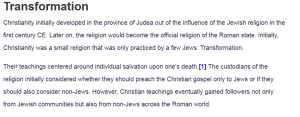Transformation
Christianity initially developed in the province of Judea out of the influence of the Jewish religion in the first century CE. Later on, the religion would become the official religion of the Roman state. Initially, Christianity was a small religion that was only practiced by a few Jews: Transformation.
Their teachings centered around individual salvation upon one’s death.[1] The custodians of the religion initially considered whether they should preach the Christian gospel only to Jews or if they should also consider non-Jews. However, Christian teachings eventually gained followers not only from Jewish communities but also from non-Jews across the Roman world.
It is worth noting that the Roman Empire did not adopt Christianity over a short time. Instead, their religious beliefs changed gradually over an extended period. Even by the time when the Western Roman Empire was falling, Christianity was still forming.[2] Notably, not even the very first Christians fully understood Christianity.
The religion was greatly influenced by Jewish traditions and continued evolving under the influence of Roman culture and political systems.[3] Overall, Judaism and Roman cultures influenced Christian beliefs; hence, most across the Roman state related to Christian preachings.
One of the notable political developments in the Roman Empire was the conflict between Christians and the emperor Nero in Rome. The conflict emanated from a fire that destroyed 10 out of 14 quarters of Rome.[4] The populace of Rome blamed Emperor Nero for the fire incident. In his defense, Nero shifted the blame to Christians for causing the fire accident.
His blame, according to the emperor, was because Christians lived near the place where the fire started. However, this did not make sense because the first Christians were Jews, and it was obvious they would live around other Jews. Another reason why Christians bore the blame is because most of them believed that Rome would be destroyed upon Jesus’s return.
As a result, their beliefs were interpreted to imply that they were responsible for the fire. The events following the fire were devastating, as multiple Christians were executed during the same summer during which the fire incident occurred.
Another notable political development was Rome’s fall into tyranny and political violence.[5] In 133 B.C.E., senators were irked by the advocacy of an elected official, Tiberius Gracchus, to distribute land to the poor. The murder was preceded by a fight between Tiberius’s supporters and opponents.
Senators joined in and beat Tiberius with wooden chairs to death. The senators also facilitated the murder of 300 of his followers. These events triggered an atmosphere of political intolerance, precipitating tyrannical rule.
During 150-750 CE, the Eastern Mediterranean experienced a significant, vibrant transformation amid Rome’s fall and decline. The period was characterized by the rise of Christianity and the emergence of new forms of governance.[6] These developments partly mirror how the people thought of themselves as different from the events seen during ancient times.
From a political perspective, late antiquity is characterized by competition among two empires. One of the political developments during this period was the Roman Empire being morphed into the Byzantine Empire. The new Empire’s culture mirrored the past Roman cultural influence and the present Christian influence.[7]
In the Eastern Mediterranean, the Sasanian Empire competed for influence with the Byzantines to gain influence. The rivalry eventually led to the emergence of small and disruptive states. The Sasanians would later take up the Persian Empire. The Sasanians adopted the Zoroastrianism religion, which emphasized the need for loyalty to the government and the royal family.
Bibliography
Gildas. 2020. “On the Ruin of Britain.” https://www.gutenberg.org/cache/epub/1949/pg1949.html.
Lendering, Jona. 2019. “Tacitus on the Christians – Livius.” Livius.org. 2019. https://www.livius.org/sources/content/tacitus/tacitus-on-the-christians/.
Sebêos, and James Howard-Johnston. 1999. The Armenian History Attributed to Sebeos.
[1] Lendering, Jona. 2019. “Tacitus on the Christians – Livius.” Livius.org. 2019. https://www.livius.org/sources/content/tacitus/tacitus-on-the-christians/.
[2] Lendering
[3] Lendering
[4] Lendering
[5] Gildas. 2020. “On the Ruin of Britain.” https://www.gutenberg.org/cache/epub/1949/pg1949.html.
[6] Sebêos, and James Howard-Johnston. 1999. The Armenian History Attributed to Sebeos.
[7] Sebeos
ORDER A PLAGIARISM-FREE PAPER HERE
We’ll write everything from scratch
Question
Sometime around the year 300CE, the “classical world” of Ancient Greece and Rome started to transition into something new and strange, which historians often refer to as “Late Antiquity.” In your essay this week, I want you to summarize transitions in the following areas:
- a. The religious affiliation of the Roman State (government)
- b. The political situation in various regions of the Roman Empire
- c. The religious/political situation in Persia and the Eastern Mediterranean
Transformation
You must cite the readings posted to Canvas and the textbook in your answers, using the Chicago Citation Style. NO USE OF AI tools.
These sites are the readings to answer the questions please use them.


